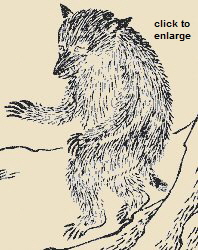|
|
|
|
MORE ABOUT THE TANUKI
This is a side page. Return to the main TANUKI page
|
|
|
Tanuki, modern, ceramic. Sake Kai Tanuki 酒買狸 (lit. Tanuki Procuring Sake). Depicted with big tummy, staff, giant scrotum, straw hat, sake flask, and promissory note. Welcoming icon found frequently outside Japan’s bars and eateries (“come in, don’t be stingy”). Also a wealth-bringing icon adorning gardens. Photo from Rakuten J-store
|
|
|
|

Tanuki standing on hind legs,
from the Kinmōzui 訓蒙圖彙 illustrated Japanese encyclopedia dated to 1666.
|
|
The Yamasa Institute, Aichi Center for Japanese Studies
Things Japanese Newsletter, #37, September 15, 2001
yamasa.org/acjs/network/english/
newsletter/things_japanese_19.html
In ceramic form it can be seen everywhere but the real thing is a little more difficult to come across. The tanuki is a rather stout, short-legged creature with a small, bushy tail and is a member of the dog family. Although the tanuki's English name is ”raccoon dog,” it is not a racoon. It is also often confused with the Japanese badger (ana-guma), which is an entirely different animal.
In Japanese folklore the Tanuki has great physical strength and supernatural powers. Like the kitsune (fox), it is a master of shape-changing and disguise and is a mischievous creature taking all sorts of disguises to deceive or annoy travellers. Standing by the road side on its hindlegs, it distends its belly (or rather scrotum) and strikes it with its forepaws. The Tanuki is also depicted in a fox like form, playing crazy and dangerous pranks with its enormous scrotum, which measures eight tatami mats!
Because of its pot belly, the Tanuki is associated with two other figures with large stomachs, the Fugu (blow) fish and Hotei, the fat, God of Luck. It is also said to be linked to the teakettle because of its appearance. The Shogun, Ieyasu Tokugawa, was irreverently referred to as Furu Tanuki, old Badger. 'Tanuki-gao' is sometimes used to describe women with rounded facial features. In present day Japan, you will often see a statue of a Tanuki outside a shop or restaurant, beckoning customers to visit the establishment.
In the past, it was hunted in Japan for its meat, its black-brown fur (used for making brushes) and its bones, which were reputed to have medicinal qualities. They were introduced to the western parts of the former U.S.S.R. for fur farming. Some escaped (or were released), and since the 1950s have spread westward into Scandinavia, and south even as far as France.
They live in heavily wooded areas, often close to water eating invertebrates, small animals (frogs, lizards, rodents and ground-dwelling or ground-nesting birds) and (particularly in autumn) seeds and berries. Where they live by the sea, tanuki will also scavenge along the tide line in search of crabs and other marine life that washes up. They are most active soon after sunset throughout the evening, and then again in the early hours of the morning, during which time they may wander for 10 to 20 km in search of food.
As tanuki have moved into suburban and even urban areas in Japan during the 1980s and 1990s, they have taken to feeding at rubbish dumps and are even fed by local people in their gardens, which is one of the reasons why they are associated with raccoons who thrive on the rubbish littering many cities. You are unlikely to see a tanuki during the winter because, though it odesn't hibernate, it puts on weight in autumn and then retreats into its burrow, from November until about April. It may emerge at times to feed, and in the warmer parts of their range, may hardly sleep at all.
The future of the Tanuki is uncertain as many tanuki have become afflicted with sarcoptic mange, a condition caused by a parasitic mite. Infected tanuki suffer from skin deterioration and progressive hair loss leaving them partially, or even entirely, bald. In this state their likelihood of suffering and dying from hypothermia is greatly increased, and since about 1990, many have been found dead during winter. It appears that mange has been able to spread out from suburban areas with high tanuki densities into wilder areas too, leading to serious declines particularly in the Kanagawa and Miyagi prefecture populations. During the late 1980s and early 1990s, mange spread rapidly and the numbers of animals suffering increased greatly.
On the upside the numbers of hunters in Japan declined during the 1980s and in a period of 10 years the number of tanuki killed by hunters halved from a peak of about 75,000 in 1981 to about 33,000 in 1990. This may go some way towards balancing the effect that mange has had on the tanuki population over the past twenty years.
Return to the main TANUKI page
|
|